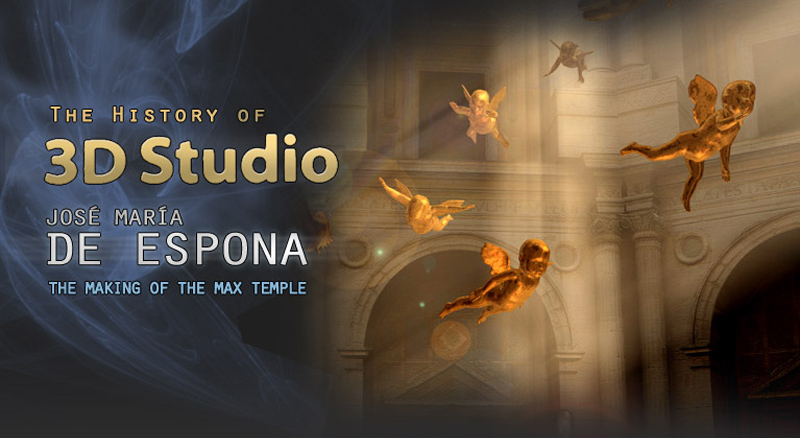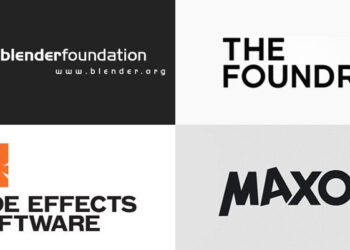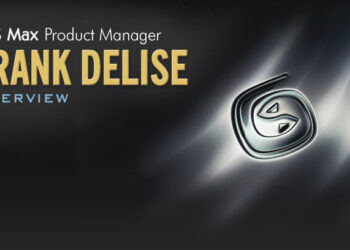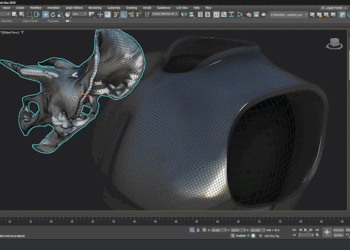From then on our relationship with Gary was constant and fluid, and during the three days of exhibition he changed the demo schedules to allow us to do our demos to the public and hand out our flyers promoting the plugins at will. I still remember telling Gary about the bleak future I thought awaited those many exhibitors who were selling software or hardware for big workstations. He replied to me, pointing at both sides of the aisle while turning around "all of this will be vanished in a couple of years…". At that time, to the eyes of the professional market we must’ve looked like a couple of psychopaths, but it was clear that Gary already had 3DStudio Max in mind.
In the coming years our relationship with Gary grew closer, we became beta testers and they listened to our suggestions and observations. We in turn sent them everything we produced with 3DStudio. Autodesk’s software catalogs and corporate videos included much of our work, and we even got word that the entrance hall at Autodesk’s premises in San Francisco had big posters of our work hanging on the walls. In 1995 Autodesk held a contest called “Planet Studio”, and I won in two categories (best rendering and TV advertisement). I still have the trophies on my bookcase.
The Max Temple
A few years later, Gary got in contact with us with a surprising, totally unexpected request. In autumn 1995 Autodesk was already preparing a mass press campaign to announce the official launch of 3DStudio Max, whose first version had been previously presented at that year’s SIGGRAPH. Autodesk had prepared a conservative campaign, consisting of a photo of a skeleton sunk in the sand, holding in his hand the box of the first version of Max. It was clear Gary wasn’t too happy with the idea. He logically wanted an image that was created 100% with 3dsmax, which would explicitly show the capabilities of the new software: its powerful modeler, volumetric lights, interactive particle systems, etc., that is, a compendium of the features that made Max something radically new. So he sent me an email asking for an image that followed this concept, telling me I had total freedom and could approach it the way I liked it the most.
Having suffered through previous years due to our fanatic, apparently absurd, intuitive, sudden jump from the professional SGI segment to the PCs and 3DStudio, it almost immediately came to mind the idea of something pseudo-religious, a metaphor of our absolute belief in what Gary and his team were doing. A Temple. I had the clear impression that the image had to be a departure from what was being produced at other 3D companies at that time. I chose an ultra-baroque style, which resulted in calls from friends and fellow designers asking if I had gone completely mad. I chose to use surrealist elements, Masonic symbols, from constructors’ guilds, from a secret initiation ritual of a secret sect, subversive and unknown to the professional production segment, which would show the capabilities of the software to create some kind of “Gestalt”, a complete, all-around tool that would enable any creator to devise any world at will at the speed of thought. My intention was to show in one image the fulfilled dream of my youth’s ambitions, the one that pushed me to leave engineering and submerge into the world of computer graphics. I myself saw Max as the final fulfillment of all that, the ability to create without limitations, without economical or technical restrictions.
Gary approved the idea immediately, but he was far from a passive agent in the creative process. He was very surprised that I included a rhinoceros on the background of the scene, but Gary is a cultured man and understood the oniric, dream-like concept of the image. He did insist on certain details, such as putting one of the cherubs kneeling at the edge of the hole on the floor, looking at the cosmos the mysterious building was floating on. I thought it was an excellent idea and did it that way.
Regarding the angels, why include cherubs instead of birds or flies or anything else that could fill the space of those volumetric lights? Well, it wasn’t an easy or arbitrary choice. In the high-tech scene we worked in, it was on the edge of a “kitsch” or “bizarre” aesthetic. Nonetheless I did not renounce to those little angels due to their metaphorical character. It was a message directed to those CG users who had gotten into the field with the sole intention of creating images. It was a simple symbol, a direct call to the purity of spirit of those that preferred the evidence of facts instead of the prejudices that distort people’s behavior. To me, it meant that they should choose based on rendering results, to trust what they had in front of their eyes, rather than any preconceived notions of the purported advantages of the ultra-costly professional workstations. To provide a final touch, in the foreground, I put a golden angel (another metaphor) looking straight into the reader’s eyes, extending his hand and saying “hey, wake up, what are you doing? This is possible and it’s happening now. You’re losing time and money, make the jump and switch from that God damned platform!”
Looking at things from today’s perspective it’s interesting to note that nothing in that image was accidental or superfluous; everything was in line with a goal, with the intention of conveying a specific meaning. There were other changes that did not come from Gary or me. The first versions included a glowing X, positioned right over the “demiurge“, the total creator located at the back of the room. That X was part of Autodesk’s initial strategy for launching the software, it was MaX’s X, and I seem to recall that at a certain moment the software was about to be called that way, X. However, some European distributors commented that the X symbol could be interpreted politically due to it being linked with a suicide commando of fascist divers that existed during world war two and were known as X-MAS, the tenth MAS. I’m not sure if other rumors regarding the X being too closely associated to US politician Malcolm X were true or totally speculative. But it’s clear at this point that this was a long creative process and as such it was easy for everyone to add all kinds of opinions.
Again, nothing was gratuitous in this process, except for my own work. I refused to accept any kind of payment for the creation of the image, except for the requisite of including my name and that of my company wherever the image was published. All printed images included the text “Image created by Jose Maria de Espona. Triplefactor. Madrid, Spain”. Autodesk kept insisting on paying me, though, so I asked Gary to give us a couple of 3DStudio Max licenses for life, a verbal agreement that regrettably was linked to the destiny of Triplefactor, a company my old partners from Telefónica and Planeta blew up in 1999. But there was another payment from Gary that I still have and keep with great affection, and that’s hanging right now over the desk at my office: a while after 3DStudio Max’s launch they sent me a huge framed cibachrome print of the “Max Temple” image.
Muchas gracias a José María De Espona for giving us such a great account of the making of of the Max Temple image, including his religious conversion from the SGI world. And also for all the trouble he took in digging up the images from old archives and generously lending them for these articles. We would also like to thank Jamie Clay for his help.
Part I: Tom Hudson interview
Part II: Gary Yost interview
Part III: De Espona on the Max Temple image











